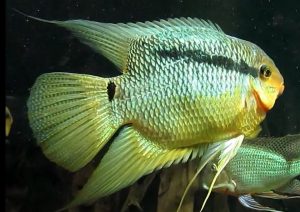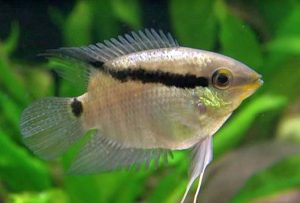Festivum (Mesonauta festivus, Cichlasoma festivum) also known to tropical fish keeping enthusiasts as Flag Cichlids or Barred Cichlids, are found throughout much of the river drainages of northern South America. They have been collected from the Rio Tapajós, Rio Jamari, Rio Madre de Dios, Rio Guaporé, Rio Mamoré, Rio Paraguay and Rio Paraná in Venezuela, Brazil, Bolivia, Paraguay and Peru.
Festivum are a shy, peaceful species that prefer densely planted, slower moving waters, where they congregate in small schools to feed on worms, crustaceans, other small zoobenthos, algae and other plant matter.
Festivum are deep bodied cichlids that have a pointed head which is more pronounced in younger specimens.
The dorsal, ventral, and anal fins are pointed, and in mature specimens often reach to the back of the caudal fins. As they mature, Festivum develop hunched backs.
All Festivum are easily identified by a dark diagonal bar (or flag) that extends from the upper part of the mouth, across the lower part of the9ir red eye, to the end of the dorsal fin tip. The body above this band is a dark shade of Brown. The balance of the body is a Greenish Yellow color that exhibits a metal like sheen.
All sub species posses a large Black spot outlined in gold atop the base of the caudal fin, and some have a similarly outlined spot in the center of the black flag. The long pectoral fins are colorless and the the dorsal, anal, and caudal fins are colored a faint yellow with small interlaced black spots. Except for the fact that the females are slightly smaller than males, their markings and colors are identical.
Several sub species of Festivum have developed distinct color patterns with slight variations in the number and arrangement of their vertical bands.
Mesonauta Insignis has seven faintly visible bars that are prominently exhibited when stressed. The 2nd and 4th bars are joined, and the scales above the diagonal flagbar are reticulated.
Mesonauta mirificus has the third bar divided, with thick horizontal lines above the diagonal flag.
Mesonauta egregius has a third bar that is divided into two.
Festivum are best housed in a densely planted tank of at least 30 gallon capacity with a sandy or very fine gravel substrate, some bogwood or driftwood branches for them to hide among, and some floating plants
to diffuse overhead lighting. They require good filtration with a moderate amount of water flow.
Although Festivm are peaceful cichlids, they do become slightly more aggressive during breeding. To minimize aggression, they should be kept with at least 10 of their own kind, or with other peaceful cichlids such as apistogramma or geophagus. They can also be housed in a community environment with other peaceful tetras, barbs, small catfish, etc.
All species of Festivum are easy to breed. Once a pair is identified, they can be separated into a separate breeding tank with some slate or flat stones. When ready to breed, the pair will prepare an area on a flat stone where the female will deposit in excess of 200 eggs that are immediately fertilized by the male.
Both parents will guard the eggs until the fry hatch out in two to three days. The minute fry are transferred by the parents to a fanned out area where they are kept until they become free swimming; usually 3 or 4 days after hatching.
It is important that the parents are left alone during this period and the tank kept in a quiet location. Festivum Cichlid parents can become easily spooked which can cause them to eat their brood.
Feed the fry newly hatched baby brine shrimp or a commercial prepared powdered fry food until they become large enough to take on regular fare.
Festivum Cichlids are omnivores that will eagerly accept prepared omnivore flakes, live, frozen, and freeze dried foods such as bloodworms, tubifex, ocean plankton, and micro cichlid pellets. Several small feedings are suggested daily, in lieu of a single large feeding.
Festivum are usually available in most tropical fish keeping shops and online when they reach 1 1/2″ to 2″ in size. Note that most “Flag Cichlids” sold in tropical fish keeping shops are Mesonauta insignis (above video), not Mesonauta festivus.
Minimum Tank Size: 30 gallons
Care Level: Moderate
Temperament: Peaceful
Hardiness: Moderately Hardy
Water Conditions: 72-82° F, dH 5-10, pH 6.5-7.5
Max. Size: 4″
Color Form: Green, Yellow, Black
Diet: Omnivore
Compatibility: Community or Single species tank
Origin: Northern South America
Family: Cichlidae
Lifespan: 7-10 years
Aquarist Experience Level: Beginner




